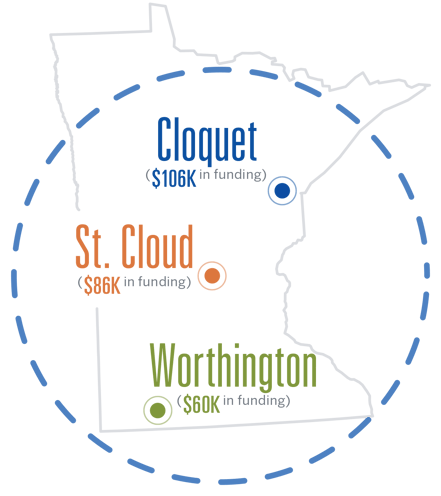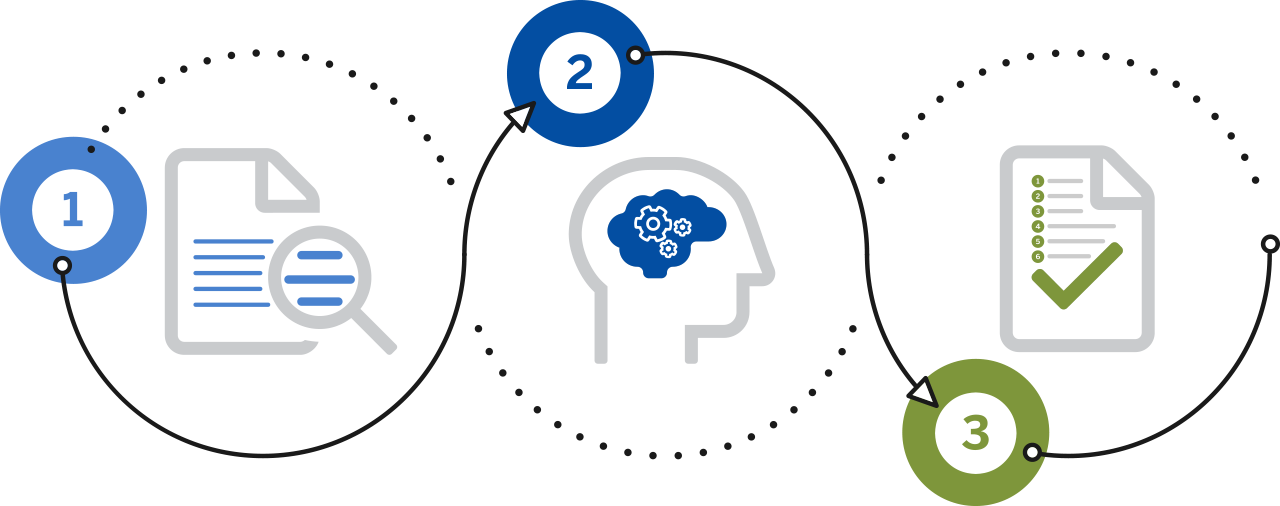Nearly every community we engage with has the same challenge: funding. In an uncertain climate with shifting costs and tightening budgets, securing your share of what’s available is critical to moving your projects and community forward.
In 2021, SEH helped three Minnesota communities secure $252,000 in funding from the Minnesota Pollution Control Agency (MPCA). Although these funds were secured through a specific program and geographical area, the lessons our team learned from this effort offer some universal tips that can help elevate a variety of state and federal funding applications.
MPCA planning grants for SWC overview
In 2021, MPCA made $870,000 in grant funding available to Minnesota communities through its Planning Grants for Stormwater, Wastewater and Community Resilience (SWC), the first year of the program. MPCA’s planning grants created the timely opportunity for communities to assess vulnerabilities and begin planning for the effects of Minnesota’s changing climate.
At SEH, we partnered with the cities of Cloquet, St. Cloud and Worthington to help them prepare successful applications and secure $252,000 of the available funds.

While every funding program is unique, the applications you submit play a critical role in determining whether your community will be selected. By gaining a precise understanding of MPCA’s priorities, paying close attention to program details and – most importantly – putting actionable plans in place within each application, we were able to help these cities secure key funding.
3 lessons learned from MPCA's program to elevate your funding applications

 1. Pay attention to the details.
1. Pay attention to the details.
This may sound simple, but details matter. One of the biggest pitfalls we see in funding applications is a misunderstanding of what’s laid out in grant program documents. Here are four details to consider:
- Project eligibility. Funding documents are often technical and complex; one word among thousands might mean the difference between your community being eligible or ineligible. If a grant spotlights which projects are eligible in general terms, make sure you dig deeper to understand what this means. For example, a document may say “water/wastewater” projects. Does this include water resources? Stormwater? Wastewater operations efforts or purely facility updates/designs? Make time to really understand the program(s) you’re interested in.
- Population size. If a document lists “population 10,000+,” does that mean all the way up to 100,000 or more? Is there a limit? If a funding program states “maximum population 10,000” and your most recent census lists a population of 9,980 but you know this number has grown to at least 11,000, how should you report this on an application? Get clarity on the parameters before investing valuable time and resources.
- Your financial obligation. MPCA’s planning grant program in 2021 covered 90%, leaving 10% to communities to pay for. This was crucial for each city to understand when piecing together applications so they could budget but also so they could communicate to MPCA how they planned to cover their obligations. Your state or federal funding application may have every requirement covered to a T with a proposed $200,000 project, but if you don’t communicate how you plan to cover your 10% ($20,000, in this example), your application will likely be tossed aside.
- Deadlines. Uncover and pay attention to the deadlines – including time of day and time zones – and do not take them for granted. Proactive application submissions stand out and ensure the weeks of work you put into securing funding aren’t bypassed because you missed the deadline by a few days, hours or even minutes.
 2. Gain a proficient understanding of favored projects.
2. Gain a proficient understanding of favored projects.
Regardless of funding program type or level, it’s critical that you understand what types of projects will be prioritized and communicate in your applications how yours will meet the program’s objectives.
Our team poured through MPCA’s planning grants to uncover the details that mattered most – i.e., what our clients needed to plan and present to help their applications stand out. Through this process, we learned MPCA’s planning grants prioritized projects that planned for and supported increased resilience within stormwater, wastewater and community/climate resilience.
Specifically, the MPCA application scoring criteria prioritized these four types of projects:
- Projects focused on addressing localized flood risks
- Projects focused on benefiting communities with vulnerable populations
- Projects that address impacts of climate change
- Projects with clear and actionable work plans
At SEH, we have deep experience with advanced hydrologic and hydraulic modeling to estimate localized flood risks. Within each application, we helped the cities communicate how they would identify risks and vulnerabilities for current and future climate conditions – like using advanced hydrologic and hydraulic modeling – but also what they would do to reduce those risks and vulnerabilities through various stormwater, wastewater and community resilience projects.
The ability to show, step-by-step, how the cities’ proposed projects would come together and check multiple boxes above elevated all three applications to the top of MCPA’s selection list.
 3. Submit actionable applications.
3. Submit actionable applications.
Practical and actionable mean showing rather than telling, and both are integral when preparing funding applications. Applications with clearly laid out plans are often prioritized.
In partnership with each city, we made certain the following action items were clearly communicated to best position their applications:
- Effective public engagement techniques. Each application laid out how the community planned to engage the community throughout the proposed projects. This showed transparency and accountability to the community.
- Actionable, updated stormwater management plans. Rainfall intensities are increasing, and stormwater management is becoming more critical and costly. Clearly communicating to MPCA that these cities intended to use the funding to develop strategic stormwater management plans showed the responsibility they feel about using funds wisely.
- Analysis of current and future rainfall scenarios. MPCA also prioritized projects that showed an ability to simulate climate change impacts, specifically how proposed projects would respond and show resilience to increased rainfall.
- Clear understanding of flood risks and project that would minimize these risks. MPCA prioritized applications that spotlighted stormwater modeling tools. In this instance, that included illustrating in the applications how SEH’s hydrologic and hydraulic modeling expertise would be used to identify and communicate each city's localized flood risks. Each application also communicated the development process and analyses around potential future projects that would reduce the risk of localized flooding within the communities.
- Construction cost estimates. Accurate and up-to-date construction cost estimates help prove to the funding program that you will be ready to strategically put shovels in the ground if/when their funding becomes available.
Applying for funding is complex and requires great care. As you search for state and federal funding to support your projects, keep the above tips in mind to make sure you’re positioning your community and projects to be selected.
Related Content: 3 Airport Leaders Share How They Secured FAA Airport Terminals Program Funding (Video)
About the Author

Jennifer Force, PG (MN), is a senior project scientist with a diverse background in site assessment and cleanup. She assists clients with due diligence through Phase I Environmental Site Assessments (ESAs), Phase II ESAs, soil vapor investigations, cleanup plan development, and securing liability assurances and regulatory approvals. Over her 30-year career, Jennifer has secured over $23 million in investigation and cleanup grants from local, state, and federal programs.

.png?width=113&name=SEH_Logo_RGB%20(1).png)
